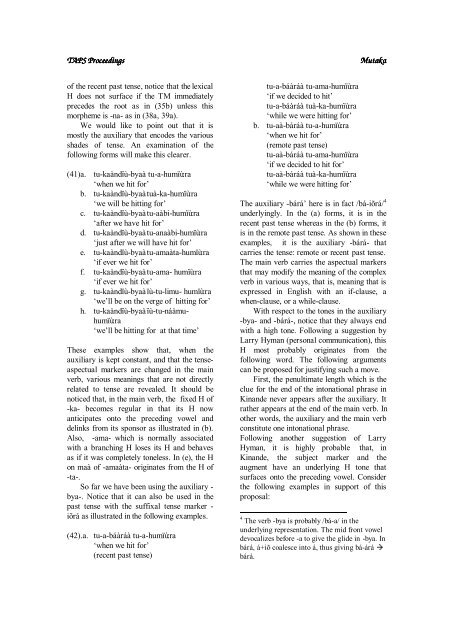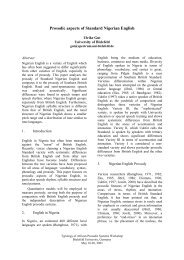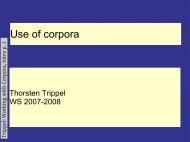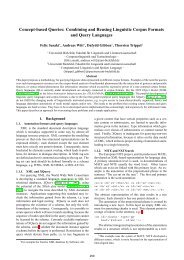The typology of tonal systems in the Kinande complex verb
The typology of tonal systems in the Kinande complex verb
The typology of tonal systems in the Kinande complex verb
You also want an ePaper? Increase the reach of your titles
YUMPU automatically turns print PDFs into web optimized ePapers that Google loves.
TAPS Proceed<strong>in</strong>gs<br />
Mutaka<br />
<strong>of</strong> <strong>the</strong> recent past tense, notice that <strong>the</strong> lexical<br />
H does not surface if <strong>the</strong> TM immediately<br />
precedes <strong>the</strong> root as <strong>in</strong> (35b) unless this<br />
morpheme is -na- as <strong>in</strong> (38a, 39a).<br />
We would like to po<strong>in</strong>t out that it is<br />
mostly <strong>the</strong> auxiliary that encodes <strong>the</strong> various<br />
shades <strong>of</strong> tense. An exam<strong>in</strong>ation <strong>of</strong> <strong>the</strong><br />
follow<strong>in</strong>g forms will make this clearer.<br />
(41)a. tu-kaàndïù-byaà tu-a-humïù:ra<br />
‘when we hit for’<br />
b. tu-kaàndïù-byaà tuà-ka-humïù:ra<br />
‘we will be hitt<strong>in</strong>g for’<br />
c. tu-kaàndïù-byaà tu-aàbi-humïù:ra<br />
‘after we have hit for’<br />
d. tu-kaàndïù-byaà tu-anaàbi-humïù:ra<br />
‘just after we will have hit for’<br />
e. tu-kaàndïù-byaà tu-amaàta-humïù:ra<br />
‘if ever we hit for’<br />
f. tu-kaàndïù-byaà tu-ama- humïù:ra<br />
‘if ever we hit for’<br />
g. tu-kaàndïù-byaà ïù-tu-limu- humïù:ra<br />
‘we’ll be on <strong>the</strong> verge <strong>of</strong> hitt<strong>in</strong>g for’<br />
h. tu-kaàndïù-byaà ïù-tu-náàmuhumïù:ra<br />
‘we’ll be hitt<strong>in</strong>g for at that time’<br />
<strong>The</strong>se examples show that, when <strong>the</strong><br />
auxiliary is kept constant, and that <strong>the</strong> tenseaspectual<br />
markers are changed <strong>in</strong> <strong>the</strong> ma<strong>in</strong><br />
<strong>verb</strong>, various mean<strong>in</strong>gs that are not directly<br />
related to tense are revealed. It should be<br />
noticed that, <strong>in</strong> <strong>the</strong> ma<strong>in</strong> <strong>verb</strong>, <strong>the</strong> fixed H <strong>of</strong><br />
-ka- becomes regular <strong>in</strong> that its H now<br />
anticipates onto <strong>the</strong> preced<strong>in</strong>g vowel and<br />
del<strong>in</strong>ks from its sponsor as illustrated <strong>in</strong> (b).<br />
Also, -ama- which is normally associated<br />
with a branch<strong>in</strong>g H loses its H and behaves<br />
as if it was completely toneless. In (e), <strong>the</strong> H<br />
on maà <strong>of</strong> -amaàta- orig<strong>in</strong>ates from <strong>the</strong> H <strong>of</strong><br />
-ta-.<br />
So far we have been us<strong>in</strong>g <strong>the</strong> auxiliary -<br />
bya-. Notice that it can also be used <strong>in</strong> <strong>the</strong><br />
past tense with <strong>the</strong> suffixal tense marker -<br />
iõrá as illustrated <strong>in</strong> <strong>the</strong> follow<strong>in</strong>g examples.<br />
(42).a. tu-a-báàráà tu-a-humïù:ra<br />
‘when we hit for’<br />
(recent past tense)<br />
tu-a-báàráà tu-ama-humïù:ra<br />
‘if we decided to hit’<br />
tu-a-báàráà tuà-ka-humïù:ra<br />
‘while we were hitt<strong>in</strong>g for’<br />
b. tu-aà-báráà tu-a-humïù:ra<br />
‘when we hit for’<br />
(remote past tense)<br />
tu-aà-báráà tu-ama-humïù:ra<br />
‘if we decided to hit for’<br />
tu-aà-báráà tuà-ka-humïù:ra<br />
‘while we were hitt<strong>in</strong>g for’<br />
<strong>The</strong> auxiliary -bárá’ here is <strong>in</strong> fact /bá-iõrá/ 4<br />
underly<strong>in</strong>gly. In <strong>the</strong> (a) forms, it is <strong>in</strong> <strong>the</strong><br />
recent past tense whereas <strong>in</strong> <strong>the</strong> (b) forms, it<br />
is <strong>in</strong> <strong>the</strong> remote past tense. As shown <strong>in</strong> <strong>the</strong>se<br />
examples, it is <strong>the</strong> auxiliary -bárá- that<br />
carries <strong>the</strong> tense: remote or recent past tense.<br />
<strong>The</strong> ma<strong>in</strong> <strong>verb</strong> carries <strong>the</strong> aspectual markers<br />
that may modify <strong>the</strong> mean<strong>in</strong>g <strong>of</strong> <strong>the</strong> <strong>complex</strong><br />
<strong>verb</strong> <strong>in</strong> various ways, that is, mean<strong>in</strong>g that is<br />
expressed <strong>in</strong> English with an if-clause, a<br />
when-clause, or a while-clause.<br />
With respect to <strong>the</strong> tones <strong>in</strong> <strong>the</strong> auxiliary<br />
-bya- and -bárá-, notice that <strong>the</strong>y always end<br />
with a high tone. Follow<strong>in</strong>g a suggestion by<br />
Larry Hyman (personal communication), this<br />
H most probably orig<strong>in</strong>ates from <strong>the</strong><br />
follow<strong>in</strong>g word. <strong>The</strong> follow<strong>in</strong>g arguments<br />
can be proposed for justify<strong>in</strong>g such a move.<br />
First, <strong>the</strong> penultimate length which is <strong>the</strong><br />
clue for <strong>the</strong> end <strong>of</strong> <strong>the</strong> <strong>in</strong>tonational phrase <strong>in</strong><br />
K<strong>in</strong>ande never appears after <strong>the</strong> auxiliary. It<br />
ra<strong>the</strong>r appears at <strong>the</strong> end <strong>of</strong> <strong>the</strong> ma<strong>in</strong> <strong>verb</strong>. In<br />
o<strong>the</strong>r words, <strong>the</strong> auxiliary and <strong>the</strong> ma<strong>in</strong> <strong>verb</strong><br />
constitute one <strong>in</strong>tonational phrase.<br />
Follow<strong>in</strong>g ano<strong>the</strong>r suggestion <strong>of</strong> Larry<br />
Hyman, it is highly probable that, <strong>in</strong><br />
K<strong>in</strong>ande, <strong>the</strong> subject marker and <strong>the</strong><br />
augment have an underly<strong>in</strong>g H tone that<br />
surfaces onto <strong>the</strong> preced<strong>in</strong>g vowel. Consider<br />
<strong>the</strong> follow<strong>in</strong>g examples <strong>in</strong> support <strong>of</strong> this<br />
proposal:<br />
4 <strong>The</strong> <strong>verb</strong> -bya is probably /bá-a/ <strong>in</strong> <strong>the</strong><br />
underly<strong>in</strong>g representation. <strong>The</strong> mid front vowel<br />
devocalizes before -a to give <strong>the</strong> glide <strong>in</strong> -bya. In<br />
bárá, á+iõ coalesce <strong>in</strong>to á, thus giv<strong>in</strong>g bá-árá<br />
bárá.










